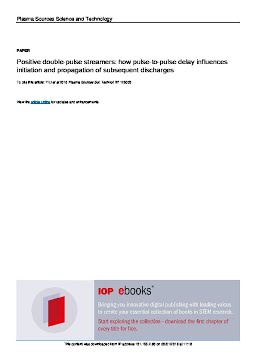2018-12-24
Positive double-pulse streamers: how pulse-to-pulse delay influences initiation and propagation of subsequent discharges
Publication
Publication
Plasma Sources Science and Technology , Volume 27 - Issue 12 p. 125003:1- 125003:15
Residual charges and species created by previous streamers have a great impact on the characteristics of the next discharge. This is especially pronounced in repetitively pulsed discharges, where the physical and chemical reactions during the decay phase play a very important role. We have performed double-pulse streamer experiments in artificial air and pure nitrogen with a varying pulse delay (Δt) from 0.45 μs to 20 ms. We have observed morphological transformations of the 2nd-pulse streamer as a function of Δt and classified six typical stages by streamer length. The propagation distance of the 2nd-pulse streamer can be 66% longer than the 1st-pulse in 66.7 mbar nitrogen, while it is 37% longer in air under the same conditions. However, we find that the longer propagation distance of the 2nd-pulse streamer in N2 is not caused by a higher velocity nor by fast gas heating of previous channels under our experimental conditions, but by earlier inception which gives more time to propagate during the pulse. In air, on the other hand, the streamers initiate almost at the same time in both pulses but the inception cloud of the 2nd-pulse streamer breaks up earlier. The onset of every stage occurs at smaller Δt in air than in N2 at the same pressure. These observations imply that different mechanisms work in N2 and air, e.g. photoionization and attachment.
| Additional Metadata | |
|---|---|
| , , , | |
| doi.org/10.1088/1361-6595/aaf2c6 | |
| Plasma Sources Science and Technology | |
| Organisation | Centrum Wiskunde & Informatica, Amsterdam (CWI), The Netherlands |
|
Li, Y., van Veldhuizen, E. M., Zhang, G., Ebert, U., & Nijdam, S. (2018). Positive double-pulse streamers: how pulse-to-pulse delay influences initiation and propagation of subsequent discharges. Plasma Sources Science and Technology, 27(12), 125003:1–125003:15. doi:10.1088/1361-6595/aaf2c6 |
|

